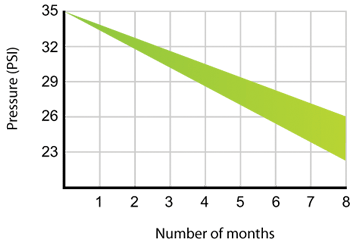Adjust your tire pressure every month



Maintaining the correct tire pressure is not only essential to safe driving, it also allows you to save on fuel and extend the life of your tires.
The wrong tire pressure alters tire contact with the road surface. Underinflated tires become deformed and increase the rolling resistance of the vehicle, which leads to more fuel consumption. Conversely, overinflated tires reduce the traction force of the vehicle and can be hazardous.
| Over time, tire pressure declines as air escapes through the tire itself. This perfectly normal phenomenon can reach 2 psi per month. The graphic below illustrates this affect over time. |  |
- Did you know that more than 1 in 4 vehicles on Québec roads have underinflated tires during the summer months? More than 50 million litres of fuel could be saved every year if all drivers adequately maintained their tires.
In addition to air losses over time, outdoor temperature variations also affect tire pressure. It is estimated that a 5 degree drop in temperature leads to a reduction in pressure of about 1 psi in each tire. So if you want to reduce your fuel consumption, be sure to regularly check the condition of your tires, especially after an abrupt change of temperature.
| The pressure of your tires should only be measured when your vehicle has been stopped for at least three hours or has not travelled more than two kilometres. Consult the indications on the side of the drivers door, inside the fuel hatch, or in the owner’s manual to determine the tire pressure recommended by the manufacturer of your vehicle. |
|
- Don’t keep your winter tires on year-round. Not only are they less efficient at evacuating water in summer, they increase fuel consumption due to the greater rolling resistance.
- Check your tire pressure a few days after your winter tires have been installed. The difference in temperature between the garage and outside can lead the tires to become underinflated after leaving the garage, even if the pressure was perfect inside.
For further information, visit the "Be Tire Smart – Play Your PART" Website, sponsored by The Rubber Association of Canada and the Government of Canada under the leadership of Natural Resources Canada's Office of Energy Efficiency.
Ref. : Quality Alliance. accélére intelligemment, essai CAA-Québec
Ref. : Quality Alliance. accélére intelligemment, essai CAA-Québec









